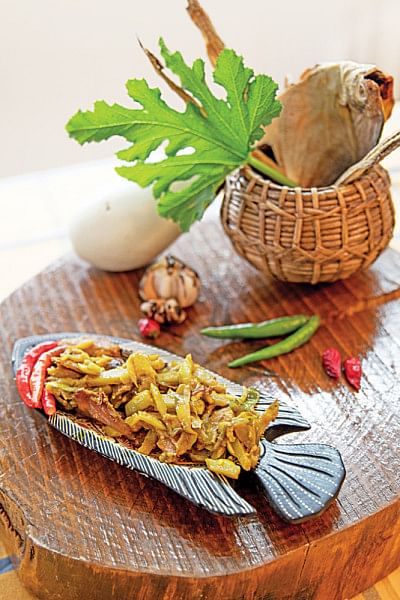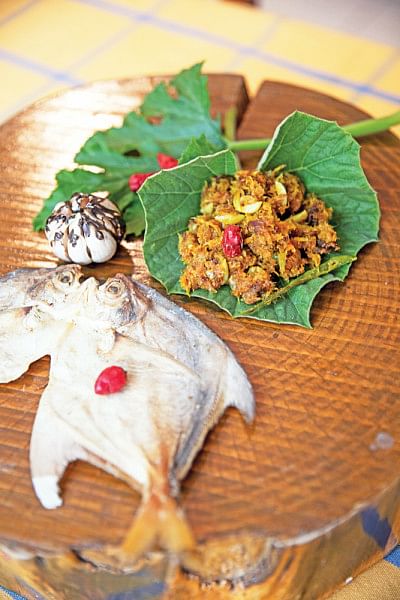Fresh fish or shutki?

Shutki is often on the list of favourite foods in a Bengali household. Those who love shutki love it for its intense aroma. Those who avoid it or don't like it, do so for the same reason as well. There is another group straddling the middle, who can't stand the smell shutki gives out during cooking, but love to eat it nonetheless. For them, shutki only becomes a delicacy once it's cooked and served.
It begs the question, however, that despite having so much fresh fish, why must Bengalis have shutki? It is true that many people who live along the riverside areas aren't particularly fond of shutki. For example, people in Patuakhali, Barisal, Bhola or Barguna prefer fresh fish. A lot of people in this region don't want to eat shutki, and they don't cook it either.
How did shutki come to be?
Shutki was the result of a necessity. This necessity was that of preservation. Fresh fish easily goes bad, so an old way of preserving fish was to dry it under the sun and turn it into shutki. The water content of the fish evaporates in this method. This practice of drying fish under the sun in open air is an ancient one.
In Bangladesh, shutki is produced between the months of October and April. The lion's share of sea fish derived shutki is produced in Cox's Bazar. Various chemicals and pesticides may be used during production to preserve shutki for extended periods of time, causing grave harm to the human body.

The heartland of shutki
No one ever visits Dubla'r Char in the Sundarbans, Saint Martin's Island, Sonadia, Maheshkhali, Cox's Bazar, Naziratek, Ibrahimpur in Sunamganj, Mymensingh, the Chalan Beel region, or Sirajganj without bringing some shutki back with them.
The regions mentioned above produce shutki from both freshwater and saltwater fishes. The fishermen in these regions produce shutki from a sizable chunk of their catch, because shutki can be preserved for many days and it has high market demand. In fact, in times of trouble, many families live on shutki and the income it brings in.
Shutki is valuable
No matter how much some people might be put off by shutki, it's actually quite expensive. The most expensive shutki are the ones made from lakkha and rupchanda fish. A kilogram of good quality rupchanda shutki can go for anywhere between Tk 3,000 to Tk 4,000, and lakkha shutki goes for between Tk 4,000 to Tk 5,000. Chhuri shutki is sold between Tk 800 to Tk 1,200. The prices in Dhaka are usually much higher than those in Chattogram or Cox's Bazar. The cheaper shutki is the mixed variety of different kinds of fishes. But the most popular by far is laitta shutki. Sweetwater shutki is usually made from small fish.
Mind-blowing chepa
Chepa is another shutki whose mere mention is a mouth-watering prospect. Even though it's mainly prevalent in the larger Mymensingh region, it's available in different regions of the country and known by different names, such as sidhol or sidoil, hidol (regional name in Mymensingh and Cumilla), and byarma (in the hill tracts). Its English name, "semi-fermented fish" is used when exported abroad.
Chepa is produced using puti shutki with traditional fermentation methods. The smell of chepa is so intense that for those who don't like shutki, it causes much discomfort. On the other hand, those who like chepa shutki like it for its characteristic taste and smell.

Although chepa shutki is popular in Mymensingh and the greater Jashore region, not many people in the North of the country eat it, or are even familiar with it. In Kishoreganj, Mymensingh, Narsingdi, Sylhet, Cumilla and Narayanganj, chepa is the most highly produced variety of shutki. There is a lot of variety in its preparation as well. Many people have chepa shutki with chipped rice and rice cakes as well.
For a long time, I was unfamiliar with this shutki as I hail from Northern Bengal. Then I noticed one day that my cooking assistant at home made spicy chepa shutki with vegetables for their own family. That is when I first tasted it. I didn't like the taste or smell of it then. So, the question persisted, why do people like chepa shutki so much?
Later on, a co-worker's mother prepared some chepa shutki for me. It tasted heavenly. She made it with lots of garlic, onions, and green chillies. Then I had a similar chepa bhorta with a red chilli paste. The eating process involved a lot of tears and pain, but it was so good that I couldn't stop.
In Narsingdi, I had chepa shutki wrapped in pumpkin leaves. Chepa is prepared with aubergine, potatoes, taro, gourd greens, and loti. Others prepare it with taki or shol fish (varieties of snakeheads). I am now a fan of chepa shutki as well. A weekly dose of chepa has become the norm for me.
The shutki roundup
Other than that, people like having shutki of freshwater fishes such as rui, katla, puti, taki, shol, mola, dhela, tengra, bain, gochi, shrimp, etc. Among the shutkis made from saltwater fishes, only laitta may be the one that is affordable for the general public. Rupchanda, folichanda, lalpowa, chhuri, lakkha, jatka, choukka, guijja can all be turned into shutki. In the winter, when the lakes and canals dry up, people catch fish in bulk and prepare shutki from them.
Not forgetting nona ilish
The shutki that is made from ilish has a special name – nona ilish. Nona ilish is used in all sorts of delicious dishes, which is why it's a favourite for Bengalis, home and abroad. To make nona ilish, the gills, intestines, and any remaining eggs are first removed before coating the fish with a mixture of salt and turmeric. Then its mouth is tightly bound with a bit of rope to make it airtight, and it is kept like this for 20-25 days to produce nona ilish.
Nona ilish bhorta with steaming hot rice, nona ilish with aubergine, nona ilish wrapped in leaves, nona ilish with pumpkin and gourd greens and even nona ilish curry with vegetables — they all make delightful dishes. To preserve nona ilish year around, they can be kept in freezers. It is said that shutki has higher calcium and mineral content compared to fresh fish. But it's not clear how much of the nutritional value remains after the cooking process.
Nappi in the hill tracts
Nappi is a favourite among the communities of the hill tracts. Peoples make use of nappi to elevate the taste of their dishes. This is just another form of chepa shutki. Members of the Rakhine community in Cox's Bazar, Kutubdia and Maheshkhali usually produce nappi, which has the intense aromas of saltwater shrimp and other small fish. It includes some other ingredients as well. Even though it has an intense smell, those in the hill tracts believe it is second to none when it comes to elevating the flavours in a dish.
Nappi is wrapped in leaves from a banana tree and burned until it's hard before being applied to dishes. It can also be mixed with water and directly used in cooking. Other than the three districts in the hill tracts, nappi is highly valued in Chattogram, Barisal, Barguna, and Patuakhali. Every month, nappi is being exported across the border through Teknaf and the Chittagong Hill Tracts to India and Myanmar. In various restaurants in Thailand and even Indonesia and Sri Lanka, shutki items like nappi are being served.
The preparations of shutki
All these flavours of shutki rely on the different regional cooking methods to be able to express themselves fully. In some regions, they like having a brothy curry of shutki made from bigger fishes. Some people like a drier curry made with tomatoes. Aubergines, kochu, and potatoes are common in preparations of shutki. But shutki dishes across the board must be spicy. People in the northern regions have less shutki than people in the south, hence there is a smaller variety of preparations as well.
There are few hotels and restaurants in this country that don't serve some form of shutki. In the winter, shutki bhuna is sold with bhapa pitha and chitoi pitha on the streets of Dhaka. Those who don't want the sweet and coconutty taste love eating pitha with shutki, coriander or mustard paste.
Translated by Azmin Azran
Photo: Sazzad Ibne Sayed

 For all latest news, follow The Daily Star's Google News channel.
For all latest news, follow The Daily Star's Google News channel. 


Comments